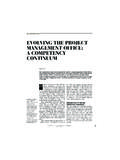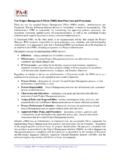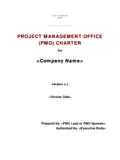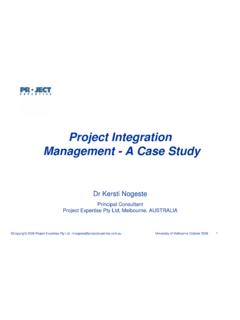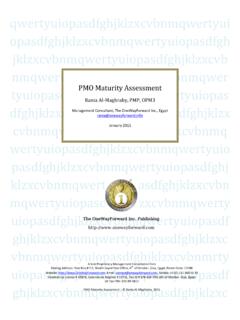Transcription of Executive summary - iPlanWare PPM
1 Creating a project management office (PMO) Executive summary The project management office (PMO) was initially developed to define and maintain standards for project management in the organisation. In many organisations, the PMO has developed a strategic role involved in helping the organisation make better decisions such as which projects to run, optimising the allocation of resources and the constant evaluation and appraisal of in progress projects. White Paper Typical functions of a PMO The PMO was originally conceived as a way of setting standards and establishing best practice principles for project management through the organisation.
2 In many organisations this is still the main remit of the PMO. However, in many organisations the remit of the PMO has now widened to include functions such as stakeholder communication, data analysis and facilitating resource allocation decisions. For organisations with a portfolio management (PPM) process, the PMO becomes the platform for capturing project requests (demand), facilitating the project selection and prioritisation process and monitoring ongoing project and portfolio performance. Why implement a PMO? With the organisations we work with, a common set of points are articulated and drive the decision to implement a project management office .
3 project failures. Too many projects are late or not delivering the results envisaged. The quality of deliverables is poor or the customer is dissatisfied. Cost reduction. Duplicate projects are happening in the organisation, cost estimates vary to the actual project costs incurred, projects are inadequately funded. Insufficient information. management do not understand what projects are being executed and the status of the projects. management learn about projects only when they are in trouble. What information management does have about projects is out of date or inaccurate. Poor start up process / kill decisions.
4 Projects start up without any analysis or strong business case - who shouts loudest gets. Once projects are underway they are not regularly assessed or reviewed to decide if they should continue. Irrespective of the type of organisation, a PMO can make a significant contribution to project outcomes and business decisions. White Paper: Creating a project management office (PMO) Page 1 N e a r l y 7 0 % o f organisations that have implemented a PMO report that project success rates have improved significantly. (Source: Gartner Survey) White Paper Resource issues. There is no way to forecast the resource needs for committed and prospective projects.
5 Some resources are over allocated while others are under allocated. The current skills in the organisation are poorly aligned to the needs of the projects the organisation wants to execute. Poor project management practices. Projects are run in an ad-hoc way and don t share any standards, best practice or lessons learned. New project managers find it difficult to get up to speed and it is difficult to re-assign project managers between projects. Services the PMO provides Organisations must determine the scope of the PMO and the services it provides to its customers in the wider organisation. The services initially provided may only be a subset of those listed below, but as the PMO maturity grows, so can the services it provides.
6 project process, standards and template development. The PMO can develop a set of practices, standards and templates for managing projects. Consolidating and analysing data. The PMO can provide a central data capture, consolidation and analysis function feeding into other services such as status reporting, dashboards and decision support. This can include financial and timesheet information. project execution. If the project managers belong to the PMO, project management services can be provided. Status reporting and dashboards The PMO can develop standard reports and dashboards for communicating project and portfolio status to stakeholders.
7 Reviews of projects. If the project managers belong to business units, the PMO can provide a quality assurance function to check projects are following the organisation s standards for project management . Development of decision support tools. The PMO can develop tools for evaluating projects such cost / benefit models. Guidance and advice for project managers. The PMO can develop into a centre of excellence for project management and provide guidance, training and assistance to project managers. project inventory. The PMO can maintain a central inventory of projects. Resource allocation. The PMO can hold an inventory of the skills in the organisation and facilitate the resource planning and allocation process.
8 White Paper: Creating a project management office (PMO) Page 2 High performing project organisations deploy approximately 20% more key PMO capabilities t h a n c o m p a r a b l e organisations. (Source: Centre for Business Practices ) Creating a project management office (PMO) White Paper Demand management . The PMO can maintain an inventory of the demands being made on resources (both new projects and changes to existing projects). project evaluation. The PMO can facilitate the project evaluation process and develop scoring and prioritisation models. Furthermore the PMO can implement a project request process and ensure that requests for new projects are sufficiently detailed for assessment.
9 Centralised vs. decentralised PMO Most organisations organise their PMO into either centralised or decentralised models. In a centralised PMO the project managers work for the PMO and run projects for the business units. Whereas in a decentralised PMO, the project managers form part of the business units and the PMO takes on a consultative and guiding approach. Some benefits of a centralised PMO: Easier to control and implement standards. Easier to consolidate information. Some benefits of a decentralised PMO: PM s have better domain experience. Can be suited to highly technical projects. Who is sponsoring the PMO?
10 The PMO sponsor needs to be at a senior level in the organisation such as CFO, CIO, CTO. To identity the sponsor, it helps to keep in mind the reasons the organisation is implementing the PMO. The sponsor must be a sales person for the PMO and able to drive through the cultural and process changes that will occur on the PMO journey. People in the PMO The people required in the PMO will depend on the scale of the organisation and the services provided. Typical PMO roles include: PMO leader. Sets the strategic direction for the PMO. project manager(s). Executes the projects. Resource manager(s). Manages the resource forecasts and capacity plans.
